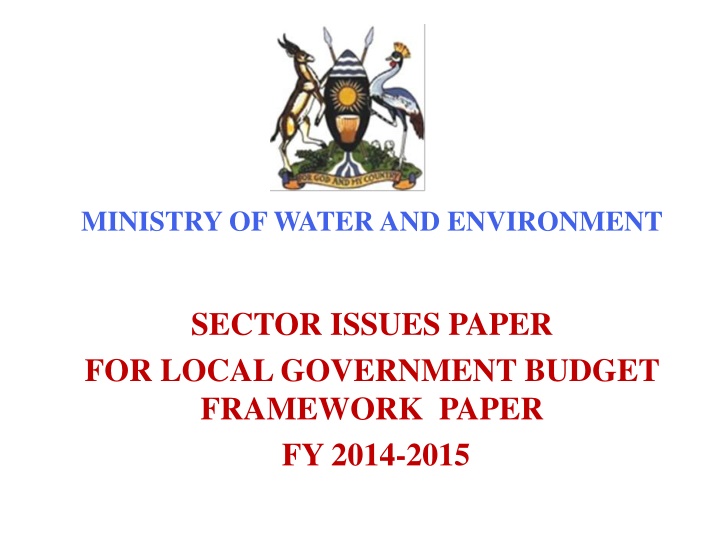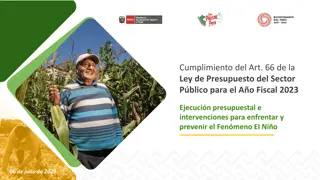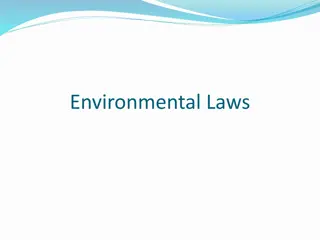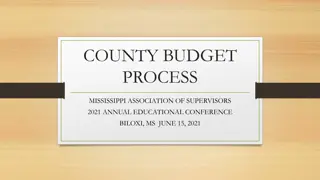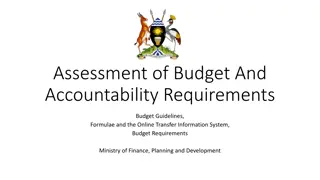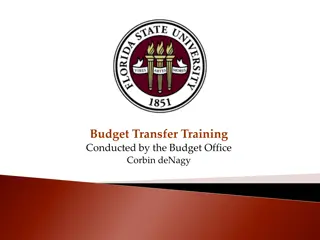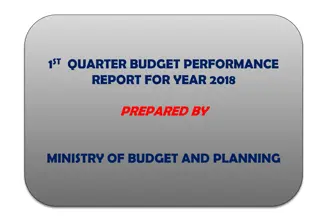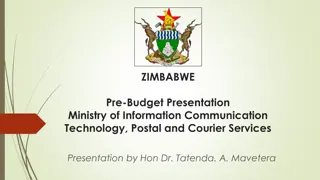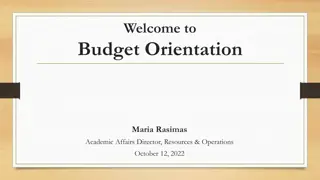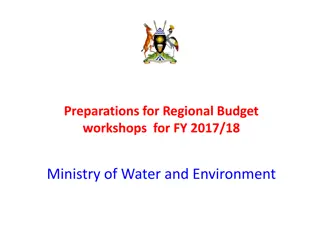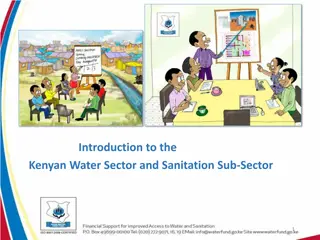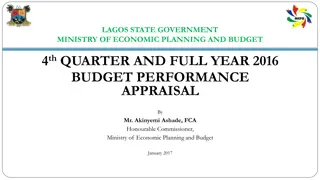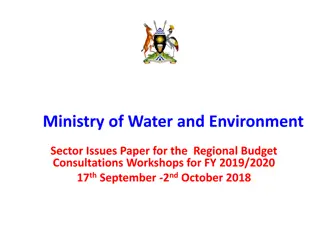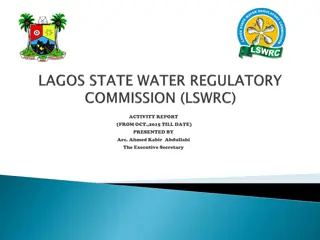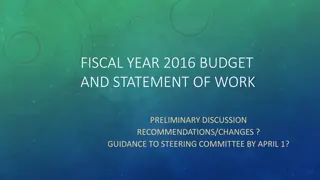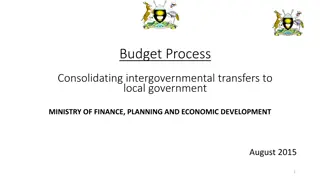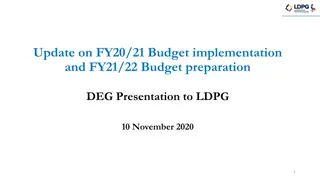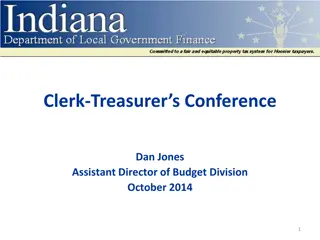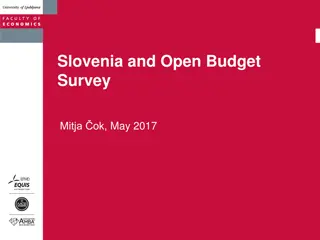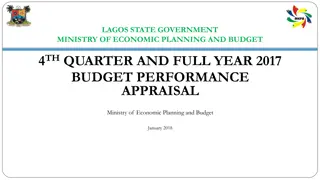Ministry of Water and Environment Sector Issues Paper for Local Government Budget Framework FY 2014-2015
This paper outlines the progress and guidelines for implementing various grants related to water, sanitation, urban operation, maintenance, and wetlands management for the fiscal year 2014-2015. It covers detailed allocations, proposed increases in grants, and actions agreed upon between the Ministry of Water and Environment and local governments.
Download Presentation

Please find below an Image/Link to download the presentation.
The content on the website is provided AS IS for your information and personal use only. It may not be sold, licensed, or shared on other websites without obtaining consent from the author.If you encounter any issues during the download, it is possible that the publisher has removed the file from their server.
You are allowed to download the files provided on this website for personal or commercial use, subject to the condition that they are used lawfully. All files are the property of their respective owners.
The content on the website is provided AS IS for your information and personal use only. It may not be sold, licensed, or shared on other websites without obtaining consent from the author.
E N D
Presentation Transcript
MINISTRY OF WATER AND ENVIRONMENT SECTOR ISSUES PAPER FOR LOCAL GOVERNMENT BUDGET FRAMEWORK PAPER FY 2014-2015
Presentation Outline 1. Introduction 2. Progress of Implementation of Agreed upon issues during negotiations between LG,s and Sectors FY 2014-15: District Water Development Conditional Grant Sanitation Conditional Grant Urban Operation and Maintenance Conditional Grant ENR Grant (Wetlands Grant) 3. Guidelines and Grant allocation formulae and IPF for FY 2014-15 4. Conclusion and Recommendations
1. Introduction Water and Environment Conditional Grants District Water Development Grant for rural water to be raised from Ush.52.92bn-UShs. 60bn District Sanitation and Hygiene Grant for district sanitation to be raised from Ush. 2bn -UShs. 3.0 bn Urban Water Supply O& M Conditional Grant to support system expansions and sustainability intended to be raised from Ushs 1.5bn to UShs. 2.5bn and, Environment and Natural provided for Wetlands Management also will be raised from the current Shs. 0.780bn to UShs. 1bn Resources Conditional Grant N.B Detailed allocation of IPFs per district is provided in the main document
2a. Progress on agreed actions for CG ENR ( Wetlands) Conditional Grant: 1. MWE to discuss the possibility of establishing new grants for other sub-sectors in the ENR Progress The MWE wrote to MFPED to up-scale the ENR MTEF, MWE has prepared guideline for creating Forestry sub-sector CG which will be discussed with MFPED 2. MWE to write to LGs providing guidelines on the operational modalities of the Environment Protection Force by 30thJune 2013 Progress A letter has been written after inter-institutional meetings with the IGP in September 2013 and disseminated to all LGs. Accessing the EPPU is free of charge.
2a. Progress on agreed actions for CG (cont) Water and Sanitation Conditional Grant 3.MWE to approve designs for Water for Production facilities before LGs can proceed to the next level of action towards construction. Progress MWE has put in place a design review committee and this has handled a number of submission made by LGs. The committee will follow-up on compliance as well as QualityAssurance 4. The MWE to review and communicate to all CAOs on the use of Monies contributed by communities at LLG for rehabilitation of boreholes Progress Task force put in place and draft report prepared but further consultations with stakeholders are on-going to refine the guidelines The guideline will be ready in FY 2014-2015 and will be communicated to all CAOs
2b. MWE and LGs agreed Actions for FY 2014-15 ENR Grant should cover Municipalities The inadequacy of wetlands CG which cannot even cater for the wetlands under the Municipal Councils. Need for MWE to provide latest wetland coverage by districts. AgreedAction The District Wetland Action Plans has always included the Municipal Wetlands and should continue to do so. MWE has developed latest wetland coverage by district and will be adopted during allocating CG fund for FY 2014-15. DEO should develop DWAPs indicating priorities funding for District and Municipal council wetlands.
2b. MWE and LGs agreed Actions for FY 2014-15. Encroachment, degradation and restoration of ecosystem Encroachment and ecosystem degradation is on the increase and no effort for restoration. MWE developed a strategy for demarcation of wetland and forests and being used to demarcate and restore 11 critical urban wetlands. AgreedAction LGs to use this strategy for demarcating boundaries of wetland and forest reserves and restoring degraded sections. LGs are encouraged to conduct an inventory of potential Natural Resources that need value addition and those that require restoration, Plan and budget for a restoration project for degraded sites and District WetlandsAction Plans. Districts should carry out the awareness, routine monitoring and surveillance and carryout law enforcement with support of the Environmental Protection Police (EPPU) Promote establishment and maintenance of green belts in the Town Councils, Municipals and City councils including tree planting along road reserves
2b. MWE and LGs agreed Actions for FY 2014-15 Management of forest resources on private and customary land Government recognizes the need to manage private and customary forests as well as increasing tree planting for sustainable forest cover. AgreedAction LGs should establish an inventory of tree planting (i.e. seedlings planted) per district each year. Mobilize and provide forestry communities and private tree farmers Promote tree planting in all districts especially on national tree planting gazetted days Register private and customary forests Sensitize and make awareness management through forest management planning extension services to on sustainable forest
2b. MWE and LGs agreed Actions for FY 2014-15 Vandalism of Meteorology Equipment in districts There are increasing cases of vandalism of Meteorology equipment in districts. MWE developed MoU on the protection of meteorology stations to be signed by LGs. Agreed Action LGs to provide support to the DoM in the protection of this equipment alongside other security functions. Protect and prevent encroachments of land meant for Meteorology where it exists. Allocate some land for Meteorology stations in the LGs. Support the Meteorological Assistant or the identified volunteers to carry out observations at the field offices.
2b. MWE and LGs agreed Actions for FY 2014-15 Promotion of Rain Water Harvesting MWE piloted rain water harvesting and has demonstrated tremendous benefits in availing timely safe and clean. LGs are requested to replicate this trend on a pilot basis at least 1 or 2 parishes at a time as a demonstration. Agreed action LGs to undertake pilot schemes in parishes where other cheaper water technologies are difficult by training of community based groups in construction systems. of rain water harvesting The planning, designing and construction of institutional buildings (schools, health facilities, etc) should incorporate rain water harvesting.
2b. MWE and LGs agreed Actions for FY 2014-15 Equitable distribution of Resources The MWE has noted that despite investment in the sector over the years, the penetration rate to the un-served is low. Some villages without improved water sources have remained un-served as reflected in the data in the Water Atlas 2010. Agreed action LGs should prioritize provision of water sources to villages/areas without water sources, as per the water database. Work plans that do not meet this requirement may not be approved.
2b. MWE and LGs agreed Actions for FY 2014-15 Use of district groundwater maps in planning and implementation of water supply projects The MWE prepared and disseminated G/water maps and reports to the target districts to guide planning and implementation of water supply projects. AgreedActions Use the maps in preparing the annual work plans and budgets and demonstrate the extent to which cost effectiveness in water supply provision has been addressed using the maps. Utilise the maps in all borehole siting, drilling and shallow well construction in order to ensure that the most feasible water supply technology options are considered. Use Drilling Companies with Drilling Licenses issued by MWE. All water sources should be given identification numbers . All the data on a water source such as geological, construction and installation details should be recorded.
2b. MWE and LGs agreed Actions for FY 2014-15 . Protection of Water Sources MWE has developed Water Source Protection Guidelines to help water users identify the risk to their water source and to put in place measures to protect the quality and quantity of these sources. MWE has established Water Management zones (WMZ) with offices in the four regions for purposes of supporting and working with LGs in the planning, management and protection of water resources. Agreed actions Districts should integrate these guidelines in implementation of water development projects for water sources sustainability. The district plans and reports should demonstrate how protection of water sources has been addressed. Local Governments can always contact the Water Management Zonal offices for assistance in all the above areas.
2b. MWE and LGs agreed Actions for FY 2014-15. Procurement and Contract Management There are delays in procurement management caused by PDU s waiting for all departments to submit procurement plans. Most LGs do not award contracts for major works by half year leading to low rating of the achievements of the sector. Required action MWE is following up with MFPED on possibilities of release of capital development grants by the 3rdquarter of the FY. CAOs should permit the Water Office in liaison with the PDU to specifically take its procurements to the next steps when they are ready using part of the grant. CAOs should ensure that the DWO is duly appointed as the contract manager in the sector in order to ensure quality service as guided in the procurement regulations.
2b. MWE and LGs agreed Actions for FY 2014-15 Sanitation and Hygiene Grant There is limited coordination between the Water Office and the District Health Inspector in the implementation of the activities under the grant culminating in failure to achieve timely outputs that were planned to be carried out under the Grant. Agreed Action CAOs should guide the Health and Water Departments to work together in harmony to achieve the target outputs under the Sanitation work plans using the grants jointly provided by MoH and MWE.
2b. MWE and LGs agreed Actions for FY 2014-15 Urban Water Supply O&M Conditional Grant Agreed funds to be channelled directly to the Municipality through the CAO. Then the CAO should immediately notify the Clerk/Water Authority . Noted that reporting is still weak resulting to delayed submissions of work plans and MoU s and funds are not being put to proper use which has resulted into increase in unit operating costs. Town Agreed action To improve on collaboration between LGs and Urban Authorities in order to enhance service delivery. Accounting Officers are requested to adhere to the guidelines issued for the grants and ensure proper reporting, coordination and use of the funds.
3. Guidelines for CG utilization ENR (Wetlands) Conditional Grant LGs should comply with the guidelines for the utilization of ENR (wetland) as follows Promotion of Knowledge on Environment and Natural Resources (20%) Restoration of degraded section of wetlands and their protection (30%) Formulation of district Policy and Legal frame work and their enforcement for compliance (25%) Capacity building and technical back stopping (15%). Administration and management involving (10%). NB The allocation formulae is provided in the sector report
3. Guidelines for CG utilization Guidelines for the use of District Water Development Conditional Grant On average most districts have been complying with the guidelines. That the status quo as per the 2013/2014 agreement should be upheld and the Rural Water Grant to various activities will be maintained in FY 2014/15 . AgreedActions Rural Water supply Facilities -not less than 70% Rehabilitation of boreholes and piped water schemes-up to 13% Construction of sanitation facilities -up to 3% Software activities for rural water supply and sanitation-up to 8% Supervision, monitoring and DWD operational costs should be up to 6% but if the 6% is less than Shs. 32m, then the district can automatically allocate up to Shs. 32m. NB The allocation formulae is provided in the detailed report
3. Guidelines for CG utilization O&M conditional Grant At least (60%) of the grant is allocated to the Umbrella Organizations to cater for major repairs of the water systems. Towns benefitting from Off-budget grants (e.g. Output Based Aid-OBA, from World Bank) do not qualify for Conditional Grant. The grant is for towns whose revenue cannot break-even and meet the overhead operations. Thus only towns with revenue below 115% (operational and maintenance cost 100%, water board fee (5%) and capital expenditure (10%)) can qualify for Conditional Grant. Only towns with submitted Business Plans qualify for Conditional Grant. Otherwise no data for calculation is available. The towns qualified by the above criteria receive conditional grant as Connection Subsidy Allocation (CSA) according to the following formula:
Sector Allocation criteria 1. Wetland Conditional non-wage grant p wa n = 1 ca n = 1 dp n = 1 mp n = 1 + + + + 10 3 6 5 10 i i i i i n = p wa ca dp mp i i i i i 1 i i i i i Z 34 Where; Z = Amount of the District Wetland Conditional Grant IPF figure pi = District Population pi = Total population of Uganda wai = District wetland area wai = Total National land area cai = District converted wetland area cai = National converted wetland area dpi = District wetland action plans dpi = National wetland action plans mpi = District wetland management plans mpi = National wetland management plans
Sector Allocation formulae. 4. Sanitation grant District Allocation = Total Grant / Number of benefitting districts (90) Di= ? Where Di = District Allocation, Z = Total grant = Total number of benefiting districts District allocation = 3Bn/90 = 33m NB The 26 districts excluded they do benefit from the Global sanitation fund.
Sector Allocation formulae Rural Water Conditional Grant Da= Dmin+ 1/5 1 ADPCC [(SC1P2014 x NSWCV2014 SC1CV2013 x SC1P2013) + + (SCnPn x NSWCVn SCnCV2013 x SCnP2013)] Da = Annual District Allocation Dmin + Inv.= District basic min allocation to cover the cost of office operations, overheads, O and M follow up, and some basic minimum new investments. ADPCC = Average district per capita cost for delivery of water and sanitation services (averaged over the last 3years from sector performance analysis) SC1P2013 = Sub-County population in June 2013 NSWCV2013 = National safe water coverage as at June 2013 analyzed from District Water and Sanitation Conditional Grants (DWSCG) allocations to districts = Sub-County safe water Coverage in the nth year SC1Pn = Sub-County population in the nth year 1 = Sub-county number one n = Nth Sub-county SC1CVn
Conclusion The Sector is committed in FY 2014/15 to ensure increased access to clean and sufficient water as well as a healthy environment. This is to be achieved through mobilization of more resources to enable increasing investments in large water schemes and up- scaling rain water harvesting among others. The sector will scale up demarcation of fragile ecosystems boundaries, restore the degraded sections, promote establishing of tree plantation for commercial and charcoal/fuel wood production, intensify compliance monitoring and enforcement of legal regimes including oil and gas environmental issues. As stakeholders, lets work together to ensure timely and quality service delivery to the communities.
END THANK YOU
